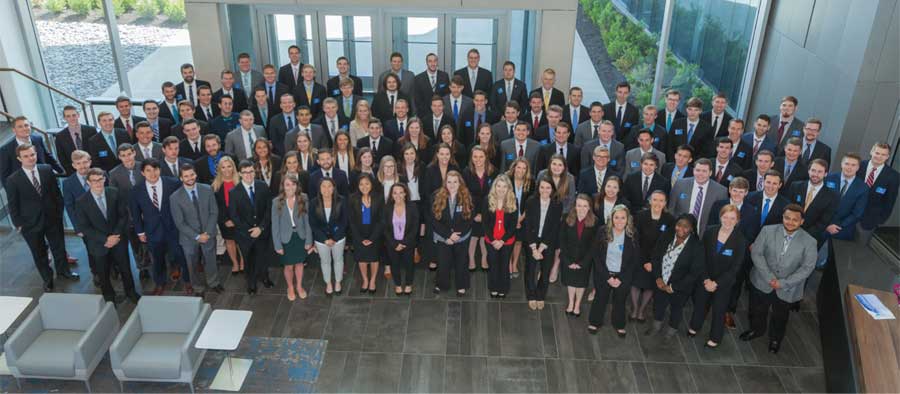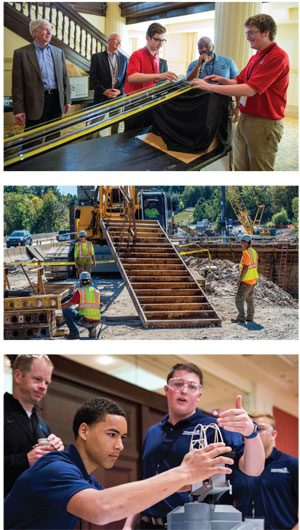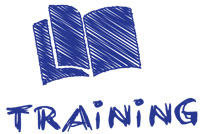May/June 2018
A Pipeline for Talent
BY DANIELLE BOYKIN
 THE BURNS & McDONNELL INTERNSHIP PROGRAM PROVIDES ITS INTERNS MENTORING, NETWORKING OPPORTUNITIES, AND EXPERIENCE ON CURRENT BILLABLE PROJECTS. NEARLY 275 INTERNS WILL PARTICIPATE DURING THE 2018 SUMMER PROGRAM.
THE BURNS & McDONNELL INTERNSHIP PROGRAM PROVIDES ITS INTERNS MENTORING, NETWORKING OPPORTUNITIES, AND EXPERIENCE ON CURRENT BILLABLE PROJECTS. NEARLY 275 INTERNS WILL PARTICIPATE DURING THE 2018 SUMMER PROGRAM.One internship experience may have changed the course of Ashley McDonald’s educational and professional life forever. After a year of freshman classes at the University of Alabama, the EIT wasn’t so sure engineering was right for her. “If I hadn’t had this real-world experience, I don’t think I would have stuck with engineering,” she recalls. “It helped me to understand that you’ve got to get through the classes and then the work out in the field is so much better.”
 A few internships later, and after graduating with a civil engineering degree, McDonald is on the path to becoming a PE at Garver, an employee-owned multidiscipline engineering, planning, architectural, and environmental services firm. She is also now paying it forward as she serves as a mentor with the same Garver internship program that changed the trajectory of her career path.
A few internships later, and after graduating with a civil engineering degree, McDonald is on the path to becoming a PE at Garver, an employee-owned multidiscipline engineering, planning, architectural, and environmental services firm. She is also now paying it forward as she serves as a mentor with the same Garver internship program that changed the trajectory of her career path.
In an increasingly competitive environment, internship and co-op programs are indispensable tools that help AEC firms and organizations that employ engineers to cultivate young budding talent. Employers in various industries and sectors are using these programs to groom and recruit graduates for entry-level positions, according to a National Association of Colleges and Employers (NACE) report. More than 62% of students who graduated in 2017 reported that they had participated in an internship or co-op program during college.

Engineering internship and co-op programs are also the best way for engineering students to get their foot in the door, build relationships, and “audition” for full-time positions. In 2017, NACE found that companies offered 67% of interns positions upon graduation and there was a 76% acceptance rate. For co-ops, the offer rate was nearly 50% with a nearly 84% acceptance rate.
Employers benefit from the relationships developed during internships through higher retention rates, according to NACE. After one year on the job, the retention rate was nearly 66% for full-time, entry-level hires who had previously participated in internships and co-ops with the firms. This is compared to a 52% retention rate of full-time, entry-level hires that had internship experiences with other companies, and 46% for hires with no internship or co-op experiences. At about five years of employment, the retention rate for previous interns was 52%, 39% for employees with other internship experiences, and 36% for employees with no internship experience.
Getting a Head Start
 Christian Boschert, E.I.T., didn’t wait until his junior or senior year to look for an internship experience. One month into his freshman year at the University of Missouri–Columbia, he began his search. This search led him to Burns & McDonnell, a full-service engineering, architecture, construction, environmental, and consulting solutions firm, in his hometown of Kansas City, Missouri. “A good reputation was one of the things I looked at when I was applying. I had always heard about the great people and the great work there,” he recalls. He got his start as a marketing intern in the firm’s business group. Upon graduating in 2016, Boschert accepted a full-time position and is on track to earn a PE license.
Christian Boschert, E.I.T., didn’t wait until his junior or senior year to look for an internship experience. One month into his freshman year at the University of Missouri–Columbia, he began his search. This search led him to Burns & McDonnell, a full-service engineering, architecture, construction, environmental, and consulting solutions firm, in his hometown of Kansas City, Missouri. “A good reputation was one of the things I looked at when I was applying. I had always heard about the great people and the great work there,” he recalls. He got his start as a marketing intern in the firm’s business group. Upon graduating in 2016, Boschert accepted a full-time position and is on track to earn a PE license.
This summer, nearly 275 interns from around the country will participate in the Burns & McDonnell internship program. Interns are matched with a mentor to assist them in transitioning from the classroom to career. The program also provides senior interns with networking opportunities, social events, and guidance to ease the transition.

THE MICHIGAN DEPARTMENT OF TRANSPORTATION HOSTS ENGINEERING OUTREACH ACTIVITIES AND A HIGH SCHOOL INTERNSHIP PROGRAM THROUGH ITS TRANSPORTATION AND CIVIL ENGINEERING PROGRAM.
Every summer, Boschert decided to return to Burns & McDonnell. “Through each internship experience I kept getting closer to determining what I wanted to do when I graduated,” he says. “The program makes it easy for you to figure this out. I was also able to apply what I learned in school to this internship and vice versa.”
The Burns & McDonnell internship also led Boschert to switch from a mechanical engineering major to electrical engineering, a change that solidified his interest in the telecommunications market. “It allows you to see what an engineer does on a daily basis. In high school, I was told ‘Hey, you’re good at math, you should be an engineer,’ but I didn’t know what that meant.”
He adds, “Even if you go into an internship and you find out that that’s something you don’t want to do, that’s also a successful internship as well.”
Ashley McDonald wants AEC firm leaders to understand how important interns and well-structured programs are to their companies. When McDonald began her internship at the Garver office in her hometown of Frisco, Texas, in 2014, she was the only intern on the aviation team and there was no uniform companywide program. “Experiencing Garver firsthand offers way more than what you will see and learn by researching the firm on our website,” she says. “When I started full-time, I felt that I was six months advanced because I knew how Garver operated. On my very first day, I was ready to go.”
As McDonald mentors Garver’s current interns, she advises them to take every opportunity to build relationships and gain the knowledge and skills they’ll need in their careers. “I let them know that these companies want to hire you. They are spending their effort and resources to make sure that you have a positive experience and can come back and contribute to the company.”
Making an Investment
 In 2016, Garver leadership embarked on formalizing its internship program because of the successful results at several offices. Adam White, P.E., helped shape the Garver Launch program. “We were able to hire graduates with at least one year of experience under their belts, and the turnover rates were almost nil because we’ve had our time to work through any kinks with them as interns,” says the project manager and aviation team leader at the firm’s Fayetteville, Arkansas office. “If you can intern for a few years prior to graduating, you probably have a nine- to twelve-month jump on someone who hasn’t participated in an internship.”
In 2016, Garver leadership embarked on formalizing its internship program because of the successful results at several offices. Adam White, P.E., helped shape the Garver Launch program. “We were able to hire graduates with at least one year of experience under their belts, and the turnover rates were almost nil because we’ve had our time to work through any kinks with them as interns,” says the project manager and aviation team leader at the firm’s Fayetteville, Arkansas office. “If you can intern for a few years prior to graduating, you probably have a nine- to twelve-month jump on someone who hasn’t participated in an internship.”
As a former two-year intern, White knows how important the experience is for students. He’s an example of how recent graduates can move up the ranks. “You learn a lot of math and science in school, but you also need to learn good communication skills, the real-life problem-solving skills, and gain experience working with a team. Those are things that you can’t do the same way in school.”
At Burns & McDonnell, Meghan Calabro, P.E., is responsible for hiring, training, and retention within the Networks, Integration & Automation Department, in addition to business development. Every year, she is impressed by the quality of engineering students who come through the intern program. It makes her job much easier. “We see this program as the best pipeline for talent because our interns are the cream of the crop,” says the department manager in the transmission and distribution division. “Our human resources professionals do a great job of screening candidates, and it’s a lot easier to hire from this pool.”
During the program, Burns & McDonnell interns go through orientation, training courses, lunches, and social and giving-back events. They work on project teams and get experience on current billable projects. They also spend time in the field and take part in client calls and face-to-face meetings. “They are treated just like any other engineer on the team and can get involved in any challenging project,” says Calabro. “It’s a full-time job for the summer, and yet it’s a great philanthropic and social program. It’s like a three-month interview.”
At the end of the internship, 85% of senior interns get job offers and 92% of them come back as full-time employee owners, says Calabro. “The interns have gotten a great head start and understand the types of projects and technologies that we are working with at Burns & McDonnell. They can be better connected than other job candidates.”
It’s Never Too Early to Engineer
Internships and co-ops are typically aimed at college students, but some organizations that are seeking engineering talent are providing these opportunities before students arrive on college campuses. In 2004, the Michigan Department of Transportation launched an engineering outreach initiative to assist middle and high school teachers with STEM education activities through the federally funded Transportation and Civil Engineering (TRAC) program. In 2008, MDOT took this outreach a step further with the TRAC internship program for graduating high school seniors. Overall, the goal of the MDOT TRAC program is to improve workforce diversity and address a critical shortage of civil engineers.
 The TRAC internship program offers up to 25 students the chance to learn about civil engineering and transportation in one of 26 MDOT offices for seven weeks during the summer. The students are employed for a 40-hour work week at above minimum wage pay and are eligible to receive a $2,500 scholarship if they major in civil engineering and attend a participating Michigan college or university.
The TRAC internship program offers up to 25 students the chance to learn about civil engineering and transportation in one of 26 MDOT offices for seven weeks during the summer. The students are employed for a 40-hour work week at above minimum wage pay and are eligible to receive a $2,500 scholarship if they major in civil engineering and attend a participating Michigan college or university.
“We are exposing students to the diverse aspects and opportunities of civil engineering with hope that they’ll become civil engineers or work in the transportation industry,” says Julie VanPortfliet, the TRAC program manager.”
TRAC interns aren’t stuck at a desk or delegated to be the office gofer when they enter the program. They are responsible for designing a small project from start to finish, all while they learn MDOT’s CAD system, get an introduction to traffic and safety engineering, and spend time in the field.
The TRAC program has become an essential talent pipeline for MDOT, with about 30% of participants going into MDOT’s traditional college co-op program. “Right now, the transportation industry needs civil engineers, and without these types of programs there is going to be a shortage and we can’t afford to let that happen,” says VanPortfliet.
Making a Good Impression
What makes an engineering student stand out when applying for an internship program? White advises that internship candidates communicate maturity and a dedication to hard work through the application process. “This can be as simple as an organized resume and showing discipline and good time management through work and volunteer activities,” he says. “Also, don’t be afraid to pick up the phone to reach out and share why you’re interested in getting an internship.”
 At Burns & McDonnell, at least 10 summer interns come through Calabro’s department. When Calabro is choosing candidates, she’s not necessarily looking for the student with a 4.0 GPA. It’s important that applicants take their studies seriously, but she prefers well-rounded students. “Of course, we want someone who is successful in his or her academic career, but someone who is involved with student or volunteer organizations and can communicate well is also an attractive candidate.”
At Burns & McDonnell, at least 10 summer interns come through Calabro’s department. When Calabro is choosing candidates, she’s not necessarily looking for the student with a 4.0 GPA. It’s important that applicants take their studies seriously, but she prefers well-rounded students. “Of course, we want someone who is successful in his or her academic career, but someone who is involved with student or volunteer organizations and can communicate well is also an attractive candidate.”
Christian Boschert has taken on the task of reaching back and recruiting students at career fairs. He always advises interns and prospective interns to work on their soft skills and, most importantly, be humble and patient. “There are a lot of people working around you that have an incredible amount of knowledge, no matter their job title; just soak up that knowledge,” he says. “You don’t have to be the smartest person on day one; you just have to work to get better each day.”
It’s also important that AEC firm leaders make a good impression on potential employees. A true commitment to mentorship is essential to making a firm’s internship or co-op program a success. “These students are going to leave with an impression of your firm, and if they leave with a bad one, they will go back to their school and talk about this experience,” says White. “You have to be committed to ensuring that the experience is useful and valuable.”
Boschert fondly recalls how his supervisor’s boss would sit at his desk with him to have a simple conversation or walk him through difficult situations. This type of mentorship and engagement positively affected his internship experience. “This meant a lot because I knew he was busy. I was also impressed with how other engineers engaged with me. This and being a part of a team kept bringing me back year after year.”
Calabro understands that the type of mentorship that an intern receives can have the greatest influence over whether an intern returns and eventually accepts a full-time position. It also makes an impact on retaining employees as well. “Our interns have great ideas and some of the suggestions that they bring to the table are amazing,” she says. “They can be huge contributors right away, but we need to invest in them and ensure they are empowered.”
 IN 2016, THE GARVER ENGINEERING FIRM FORMALIZED THE GARVER LAUNCH INTERNSHIP PROGRAM TO PROVIDE COLLEGE STUDENTS OPPORTUNITIES TO GET REAL-WORLD EXPERIENCE.
IN 2016, THE GARVER ENGINEERING FIRM FORMALIZED THE GARVER LAUNCH INTERNSHIP PROGRAM TO PROVIDE COLLEGE STUDENTS OPPORTUNITIES TO GET REAL-WORLD EXPERIENCE.

 Volunteering at NSPE is a great opportunity to grow your professional network and connect with other leaders in the field.
Volunteering at NSPE is a great opportunity to grow your professional network and connect with other leaders in the field. The National Society of Professional Engineers (NSPE) encourages you to explore the resources to cast your vote on election day:
The National Society of Professional Engineers (NSPE) encourages you to explore the resources to cast your vote on election day: